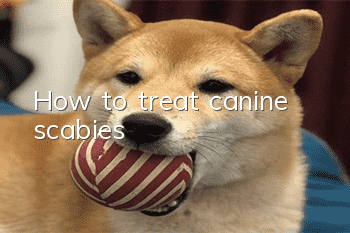How to treat canine scabies

Treatment methods for canine scabies:
1. Cut off the coat of the affected area and clean the affected area.
2. Injection therapy: 1% concentration of ivermectin. 0.5-1 mg/kg body weight, subcutaneous injection on the back, once every 6-7 months, 2-3 times as a course of treatment. Most dogs can be cured after 2-3 clinical injections.
3. Medicinal bath therapy: Lindane, 0.03-0.06% medicated bath, repeat after one week. For dogs found to have canine scabies, insecticides to kill the parasites can be purchased under the guidance of a doctor. During the medicated bath, a larger area should be removed from the medicated bath water, so that parasites can be killed to a greater extent. In addition to lindane, other reference drugs for medicated baths include: chlorfenamidine, benzamidine, pyrethroid insecticides, etc.
4. External drug therapy: Apply 0.5% trichlorfon solution to the affected area to prevent the concentration from being too high or poisoning caused by letting the dog lick it. Repeat the application after 7 days.
Prevention methods for canine scabies:
1. The main thing is to isolate dogs with scabies to prevent mutual infection.
2. Keep the environment clean. The kennel must be cleaned and disinfected regularly, and the dog must be cleaned and cared for regularly. During the peak period of canine scabies mite epidemic, attention should be paid to ventilation and light transmission, moisture-proofing and keeping the kennel dry. When cleaning your dog, try to use pet-specific bath products. Be careful not to use soaps and other toiletries that are too alkaline. Otherwise, the dog's skin will be seriously damaged. When the skin is damaged, mites will become parasitic and gradually increase, causing Canine scabies mite epidemic.
3. Strengthen the management of dogs in all aspects. The management of kennels must be strict and reasonable, so as to cut off the transmission channels and prevent the spread of epidemics. The items in the kennel must be disinfected, cleaned, and dried regularly, preferably once every half month. Pay attention to reducing the time and frequency of walking your dog during the hotter seasons of summer. Pay attention to adding some supplements to dog food, paying attention to the balance of nutrition, keeping the dog in good physical condition, and enhancing immunity and resistance.
- What are the signs of illness in golden retrievers?
- When does a dog’s awkward period begin?
- What are the symptoms before a Border Collie gives birth? Preparation for a Shepherd’s delivery!
- What are the reasons why French Dou cry so much?
- How much does it cost to neuter a male cat? Details on the price of neutering a male cat!
- No need to go to the pet hospital, these 8 daily checkups can be done at home!
- In addition to money, pet breeding also requires experience and knowledge!
- What’s wrong with dogs’ itching?
- During the peak period of dog buying, who is not suitable for raising a dog?
- How many months does it take for a dog to urinate and defecate regularly?



